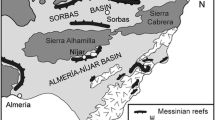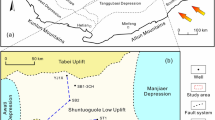Abstract
Miocene tropical carbonate platform slopes in southern Spain contain classical reef-slope facies distribution but also an unexpected abundance of serpulid-rich facies, locally forming build-ups. Two sections from the Miocene Sorbas and Níjar Basins were mapped and analyzed petrographically in order to identify the factors determining this facies variability. Reef-slope facies is intercalated with serpulid-rich facies and siliciclastic bodies. Serpulids are the pioneers colonizing the substrate in zones of quiet hydrodynamic conditions after hydrographical changes such as eventual river discharge. The interplay of sea-level changes and hydrographical conditions, together with episodic terrestrial influx, control lateral and along-slope facies variability as well as the facies distribution across the carbonate platform. Neither a deterministic distribution of facies belts nor a stochastic partitioning of facies in mosaics can accurately explain the facies distribution. A new model is proposed to explain facies variability in the context of intrinsic and extrinsic factors.












Similar content being viewed by others
References
Adams EW, Schlager W, Wattel E (1998) Submarine slopes with an exponential curvature. Sediment Geol 117:135–141
Bosence DWJ (1973) Recent serpulid reefs, Connemara, Eire. Nature 242:40–41
Braga JC, Martín JM (1996) Geometries of reef advance in response to relative sea-level changes in a Messinian (uppermost Miocene) fringing reef (Cariatiz reef, Sorbas Basin, SE Spain). Sedimrnt Geol 107:61–81
Braga JC, Martín JM, Alcalá B (1990) Coral reefs in coarse-terrigenous sedimentary environments (Upper Tortonian, Granada Basin, southern Spain). Sediment Geol 66:135–150
Braga JC, Martín JM, Riding R (1996) Internal structure of segment reefs: Halimeda algal mounds in the Mediterranean Miocene. Geology 24:35–38
Braga JC, Martín JM, Quesada C (2003) Patterns and average rates of late Neogene—recent uplift of the Betic Cordillera, SE Spain. Geomorphology 50:3–26
Climaco A, Boni M, Iannace A, Zamparelli V (1997) Platform margins, microbial/serpulids bioconstructions and slope-to-basin sediments in the Upper Triassic of the “Verbicaro Unit” (Lucania and Calabria, Southern Italy). Facies 36:37–56
Cuevas-Castell JM, Betzler C, Rössler J, Hüssner H, Peinl M (2007) Integrating outcrop data and forward computer modelling to unravel the development of a Messinian carbonate platform in SE Spain (Sorbas Basin). Sedimentology 54:423–441
Dabrio CJ, Esteban M, Martín JM (1981) The coral reef of Níjar, Messinian (uppermost Miocene), Almería Province, SE Spain. J Sediment Petrol 51:521–539
Dabrio CJ, Martín JM, Megías AG (1985) The tectosedimentary evolution of Mio-Pliocene reefs in the province of Almería (SE Spain). In: Milá MD, Rosell J (eds) Sixth European regional meeting of the international association of sedimentologists. Excursion guidebook, Lleida, Spain, pp 269–305
Esteban M (1980) Significance of the Upper Miocene coral reefs of the western Mediterranean. Palaeogeogr Palaeoclimatol Palaeoecol 29:169–188
Esteban M (1996) An overview of Miocene reefs from Mediterranean areas: general trends and facies models. Models carbonate stratigraphy Miocene reef complexes of Mediterranean regions. SEPM Concepts Sedimentol Paleontol 5:3–53
Fornós JJ, Forteza V, Martínez-Taberner A (1997) Modern polychaete reefs in western Mediterranean lagoons: Ficopomatus enigmaticus (Fauvel) in the Albufera of Menorca, Balearic Islands. Palaeogeogr Palaeoclimatol Palaeoecol 128:175–186
Franseen EK, Goldstein RH (1996) Paleoslope, sea-level and climate controls on upper Miocene platform evolution, Las Negras area, southeastern Spain. Models for carbonate stratigraphy from Miocene reef complexes of Mediterranean regions. SEPM Concepts Sedimentol Paleontol 5:159–176
Franseen EK, Mankiewicz C (1991) Depositional sequences and correlation of middle (?) to late Miocene carbonate complexes, Las Negras and Níjar areas, southeastern Spain. Sedimentology 38:871–898
Friebe JG (1994) Serpulid-bryozoan-foraminiferal biostromes controlled by temperate climate and reduced salinity: middle Miocene of the Styrian Basin, Austria. Facies 30:51–62
Giaconia F, Booth-Rea G, Martínez-Martínez JM, Azañón JV, Pérez-Peña M, Pérez-Romero J, Villegas I (2012) Geomorphic evidence of active tectonics in the Sierra Alhamilla (eastern Betics, SE Spain). Geomorphology 145–146:90–106
Jiménez AP, Braga JC (1993) Occurrence and taphonomy of bivalves from the Níjar reef (Messinian, Late Miocene, SE Spain). Palaeogeogr Palaeoclimatol Palaeoecol 102:239–251
Mankiewicz C (1988) Occurrence and paleocologic significance of Halimeda in late Miocene reefs, southeastern Spain. Coral Reefs 6:271–279
Manzello D, Liman D (2003) The photosynthetic resilience of Porites furcata to salinity disturbance. Coral Reefs 22:537–540
Martín JM, Braga JC (1990) Arrecifes Messinienses de Almería. Tipologías de crecimiento, posición estratigráfica y relación con las evaporitas. Geogaceta 7:66–68
Martín JM, Braga JC (1994) Messinian events in the Sorbas Basin in the southeastern Spain and their implications in the recent history of the Mediterranean. Sediment Geol 90:257–268
McIlreath IA, James NP (1978) Facies models 13, carbonate slopes. Geosci Can 5:189–199
Moberg F, Nyström M, Kautsky N, Tedengren M, Jarayabhand P (1997) Effects of reduced salinity on the rates of photosynthesis and respiration in the hermatypic corals Porites lutea and Pocillopora damicornis. Mar Ecol Prog Ser 157:53–59
Pedrera A, Galindo-Zaldívar J, Marín-Lechado C, García-Tortosa FJ, Ruano P, Garrido AL, Giaconia F (2012) Recent and active faults and folds in the central-eastern internal zones of the Betic Cordillera. J Iber Geol 38:191–208
Playton TE, Janson X, Kerans C (2010) Carbonate slopes. In: James NP, Dalrymple RW (eds) Facies Models 4, GEOtext 6: Geological Association of Canada. St John’s, Newfoundland, pp 449–476
Pomar L (1991) Reef geometries, erosion surfaces and high-frequency sea-level changes, upper Miocene reef complex, Mallorca, Spain. Sedimentology 38:243–269
Pomar L, Ward WC (1994) Response of late Miocene Mediterranean reef platform to high-frequency eustasy. Geology 22:131–134
Qian PY (1999) Larval settlement of polychaetes. Hydrobiologia 402:239–253
Reolid J, Betzler C, Braga JC, Martín JM, Lindhorst S, Reijmer JJG (2014) Reef slope geometries and facies distribution: controlling factors (Messinian, SE Spain). Facies 60:737–753
Riding R, Martín JM, Braga JC (1991) Coral stromatolite reef framework, Upper Miocene, Almería, Spain. Sedimentology 38:799–818
Riegl B, Piller W (2000) Reefs and coral carpets in the northern Red Sea as models for organism-environment feedback in coral communities and its reflection in growth fabrics. In: Insalaco E, Skelton PW, Palmer TJ (eds) Carbonate platform systems: components and interactions, vol 178. Geological Society, London, pp 71–88 (special publications)
Rosso A, Sanfilippo R (2005) Bryozoan and serpuloidean skeletobiont communities from Pleistocene of Sicily: spatial utilisation and competitive interactions. In: Fugagnoli A, Bassi D (eds) Giornata di studi paleontologici “Prof. C. Loriga Broglio”, Annali dell’Università di Ferrara. Sezione di Museologia Scientifica e Naturalistica. Volume speciale 2005, Ferrara, Italy, pp 115–130
Sánchez-Almazo IM, Spiro B, Braga JC, Martín JM (2001) Constraints of stable isotope signatures on the depositional palaeoenvironments of upper Miocene reef and temperate carbonates in the Sorbas Basin, SE Spain. Palaeogeogr Palaeoclimatol Palaeoecol 175:153–172
Sánchez-Almazo IM, Braga JC, Dinarès-Turell J, Martín JM, Spiro B (2007) Palaeoceanographic controls on reef deposition: the Messinian Cariatiz reef (Sorbas Basin, Almería, SE Spain). Sedimentolology 54:637–660
Schlager W (2005) Carbonate sedimentology and sequence stratigraphy. In: North CP, Milliken KL (eds) Concepts in sedimentology and paleontology 8. SEPM, Tulsa, p 200
Schlögl J, Michalík J, Zágorsek K, Atrops F (2008) Early Tithonian serpulid-dominated cavity dwelling fauna, and the recruitment pattern of the serpulid larvae. J Paleontol 82:351–361
Sola F, Braga JC, Aguirre J (2013) Hooked and tubular coralline algae indicate seagrass beds associated to Mediterranean Messinian reefs (Poniente Basin, Almería, SE Spain). Palaeogeogr Palaeclimatol Palaeoecol 374:218–229
Ten Howe HA, van den Hurk P (1993) A review of recent and fossil serpulid ‘reefs’; actuopalaeontology and the ‘Upper Malm’ serpulid limestones in NW Germany. Geol Mijnbouw 72:23–67
Wilkinson BH, Drummond CN, Diedrich NW, Rotman ED (1999) Poisson processes of carbonate accumulation on Paleozoic and Holocene platforms. J Sediment Res 69:338–350
Wilson JL (1975) Carbonate facies in geologic history. Springer, New York, p 471
Wright VP, Burgess PM (2005) The carbonate factory continuum, facies mosaics and microfacies: an appraisal of some of the key concepts underpinning carbonate sedimentology. Facies 51:17–23
Acknowledgements
The authors wish to thank the German Research Foundation (Deutsche Forschungsgemeinschaft) for financial support through the Grant Be 1272/21-1 (NEOCARPS). We also wish to thank Prof. Dr. José Manuel Martín for his insightful discussions concerning the Miocene carbonate platform slopes from Almería. The authors also thank the reviewers Prof. Dr. Juan Carlos Braga and Prof. Dr. James Nebelsick for their most valuable comments. Eva Vinx is thanked for producing the thin-sections, and JR thanks Dr. Matías Reolid for his valued support in the field and the lab.
Author information
Authors and Affiliations
Corresponding author
Rights and permissions
About this article
Cite this article
Reolid, J., Betzler, C., Singler, V. et al. Facies variability in mixed carbonate–siliciclastic platform slopes (Miocene). Facies 63, 11 (2017). https://doi.org/10.1007/s10347-016-0489-1
Received:
Accepted:
Published:
DOI: https://doi.org/10.1007/s10347-016-0489-1




